1999 TOYOTA CAMRY light
[x] Cancel search: lightPage 4429 of 4592
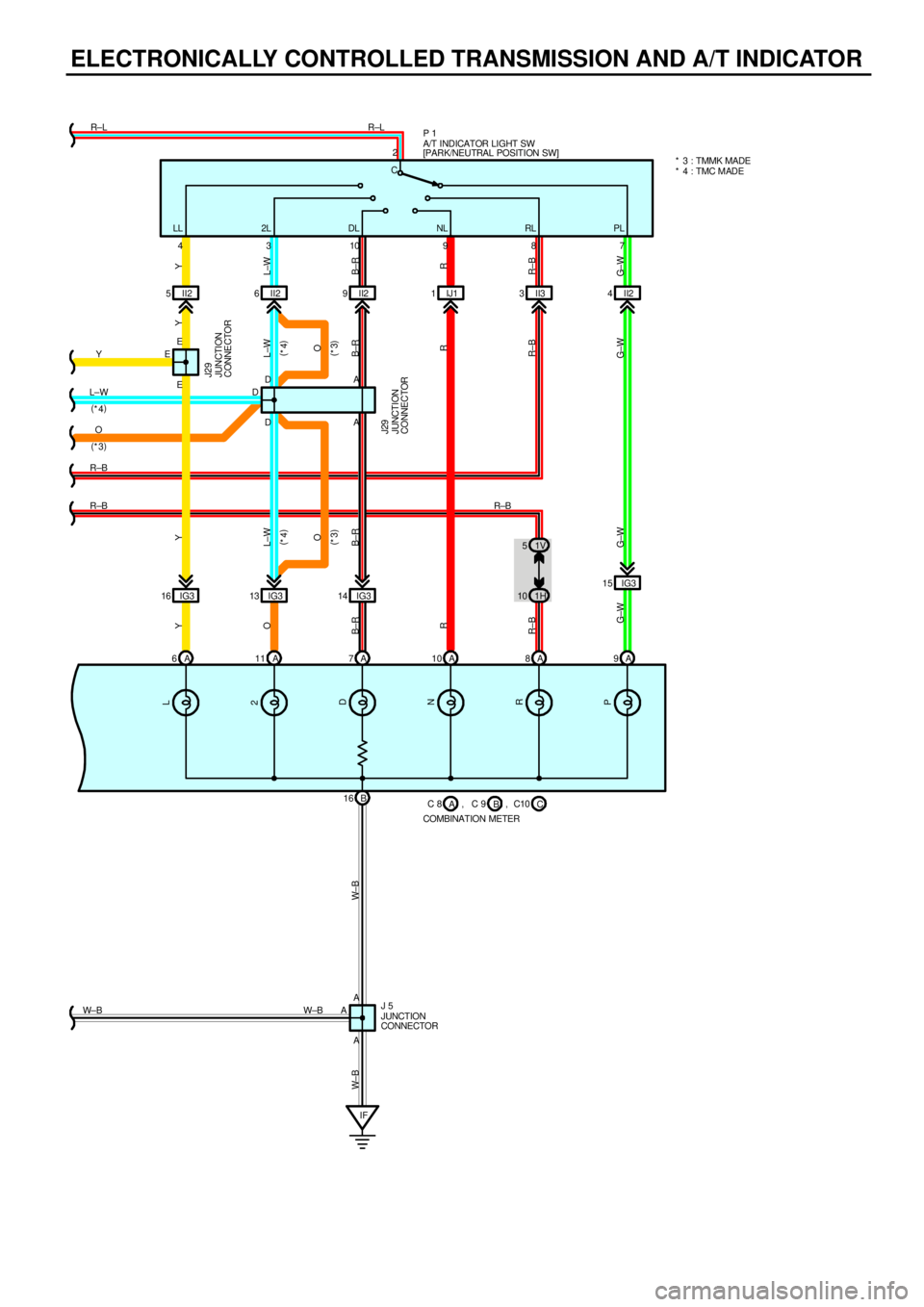
ELECTRONICALLY CONTROLLED TRANSMISSION AND A/T INDICATOR
A 6A11 A7A10 A8A9
B 16
IF II2 5 II26II29IJ11II33II24
IG3 16 IG313 IG314IG3 15 LL 2L DL NL RL PL
43109872
1V 5
1H 10 EE
DDA
AA E
DA
AR±B R±L
W±B
Y
O
B±R
R
R±B
G±WY
L±W
B±RY
L±W
B±R
R
R±B
G± W W± B W± B
COMBINATION METERB C 8 C 9
ACC10
JUNCTION
CONNECTOR J 5A/T INDICATOR LIGHT SW
[PARK/NEUTRAL POSITION SW] P 1
JUNCTION
CONNECTOR J29JUNCTION
CONNE CTOR J29 L
2
D
N
R
PY
L±W
B±R
R
R±B
G±W
W± BR±B R±B L±WY R±L
G±W
C
(
*4)
O
(
*3)
(
*4)
O
(
*3) (
*4)
O
(
*3)
, , * 3 : TMMK MADE
* 4 : TMC MADE
Page 4430 of 4592
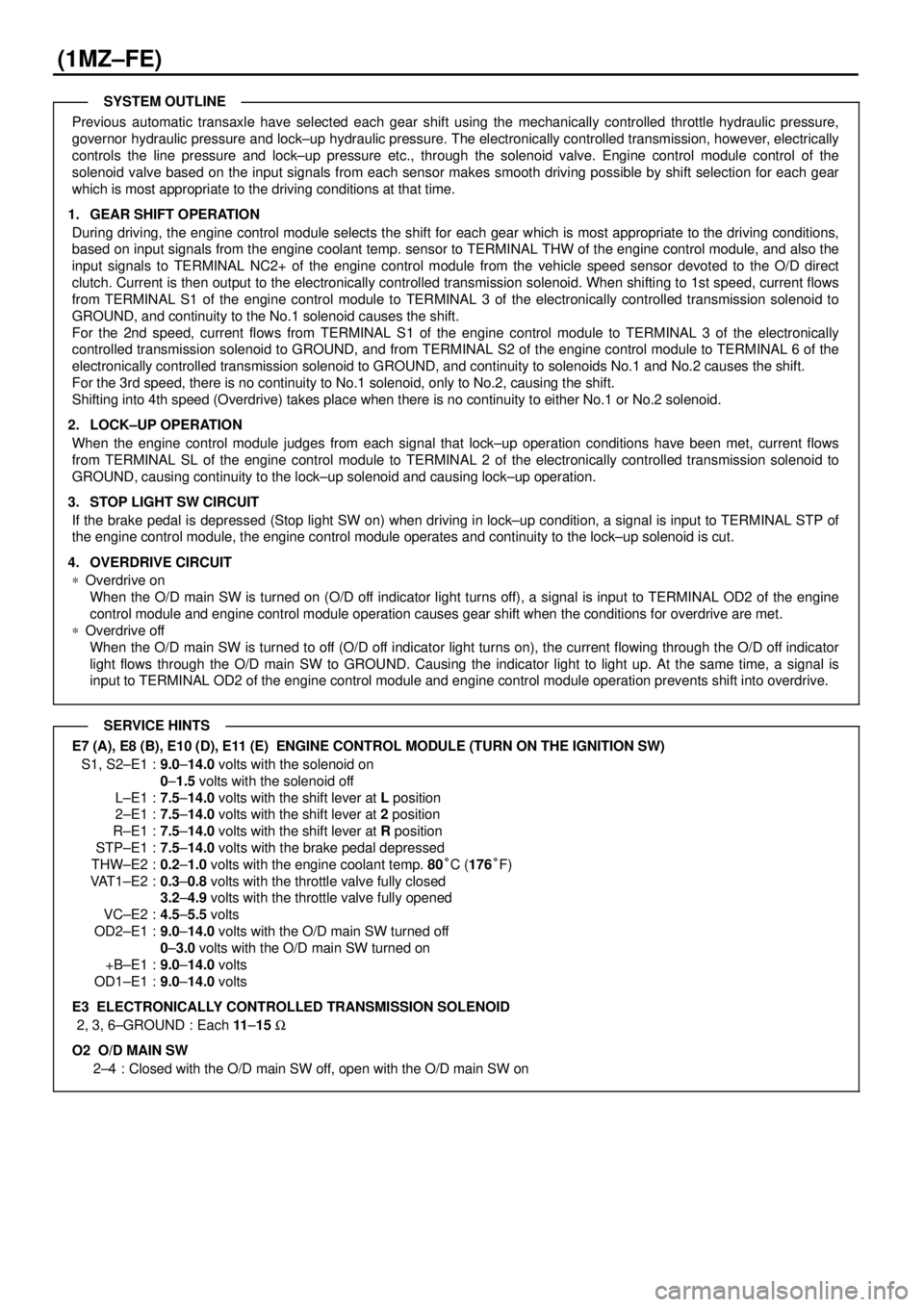
(1MZ±FE)
Previous automatic transaxle have selected each gear shift using the mechanically controlled throttle hydraulic pressure,
governor hydraulic pressure and lock±up hydraulic pressure. The electronically controlled transmission, however, electrically
controls the line pressure and lock±up pressure etc., through the solenoid valve. Engine control module control of the
solenoid valve based on the input signals from each sensor makes smooth driving possible by shift selection for each gear
which is most appropriate to the driving conditions at that time.
1. GEAR SHIFT OPERATION
During driving, the engine control module selects the shift for each gear which is most appropriate to the driving conditions,
based on input signals from the engine coolant temp. sensor to TERMINAL THW of the engine control module, and also the
input signals to TERMINAL NC2+ of the engine control module from the vehicle speed sensor devoted to the O/D direct
clutch. Current is then output to the electronically controlled transmission solenoid. When shifting to 1st speed, current flows
from TERMINAL S1 of the engine control module to TERMINAL 3 of the electronically controlled transmission solenoid to
GROUND, and continuity to the No.1 solenoid causes the shift.
For the 2nd speed, current flows from TERMINAL S1 of the engine control module to TERMINAL 3 of the electronically
controlled transmission solenoid to GROUND, and from TERMINAL S2 of the engine control module to TERMINAL 6 of the
electronically controlled transmission solenoid to GROUND, and continuity to solenoids No.1 and No.2 causes the shift.
For the 3rd speed, there is no continuity to No.1 solenoid, only to No.2, causing the shift.
Shifting into 4th speed (Overdrive) takes place when there is no continuity to either No.1 or No.2 solenoid.
2. LOCK±UP OPERATION
When the engine control module judges from each signal that lock±up operation conditions have been met, current flows
from TERMINAL SL of the engine control module to TERMINAL 2 of the electronically controlled transmission solenoid to
GROUND, causing continuity to the lock±up solenoid and causing lock±up operation.
3. STOP LIGHT SW CIRCUIT
If the brake pedal is depressed (Stop light SW on) when driving in lock±up condition, a signal is input to TERMINAL STP of
the engine control module, the engine control module operates and continuity to the lock±up solenoid is cut.
4. OVERDRIVE CIRCUIT
*Overdrive on
When the O/D main SW is turned on (O/D off indicator light turns off), a signal is input to TERMINAL OD2 of the engine
control module and engine control module operation causes gear shift when the conditions for overdrive are met.
*Overdrive off
When the O/D main SW is turned to off (O/D off indicator light turns on), the current flowing through the O/D off indicator
light flows through the O/D main SW to GROUND. Causing the indicator light to light up. At the same time, a signal is
input to TERMINAL OD2 of the engine control module and engine control module operation prevents shift into overdrive.
E7 (A), E8 (B), E10 (D), E11 (E) ENGINE CONTROL MODULE (TURN ON THE IGNITION SW)
S1, S2±E1 :9.0±14.0 volts with the solenoid on
0±1.5 volts with the solenoid off
L±E1 :7.5±14.0 volts with the shift lever at L position
2±E1 :7.5±14.0 volts with the shift lever at 2 position
R±E1 :7.5±14.0 volts with the shift lever at R position
STP±E1 :7.5±14.0 volts with the brake pedal depressed
THW±E2 :0.2±1.0 volts with the engine coolant temp. 80°C (176°F)
VAT1±E2 :0.3±0.8 volts with the throttle valve fully closed
3.2±4.9 volts with the throttle valve fully opened
VC±E2 :4.5±5.5 volts
OD2±E1 :9.0±14.0 volts with the O/D main SW turned off
0±3.0 volts with the O/D main SW turned on
+B±E1 :9.0±14.0 volts
OD1±E1 :9.0±14.0 volts
E3 ELECTRONICALLY CONTROLLED TRANSMISSION SOLENOID
2, 3, 6±GROUND : Each 11±15 W
O2 O/D MAIN SW
2±4 : Closed with the O/D main SW off, open with the O/D main SW on
SYSTEM OUTLINE
SERVICE HINTS
Page 4435 of 4592
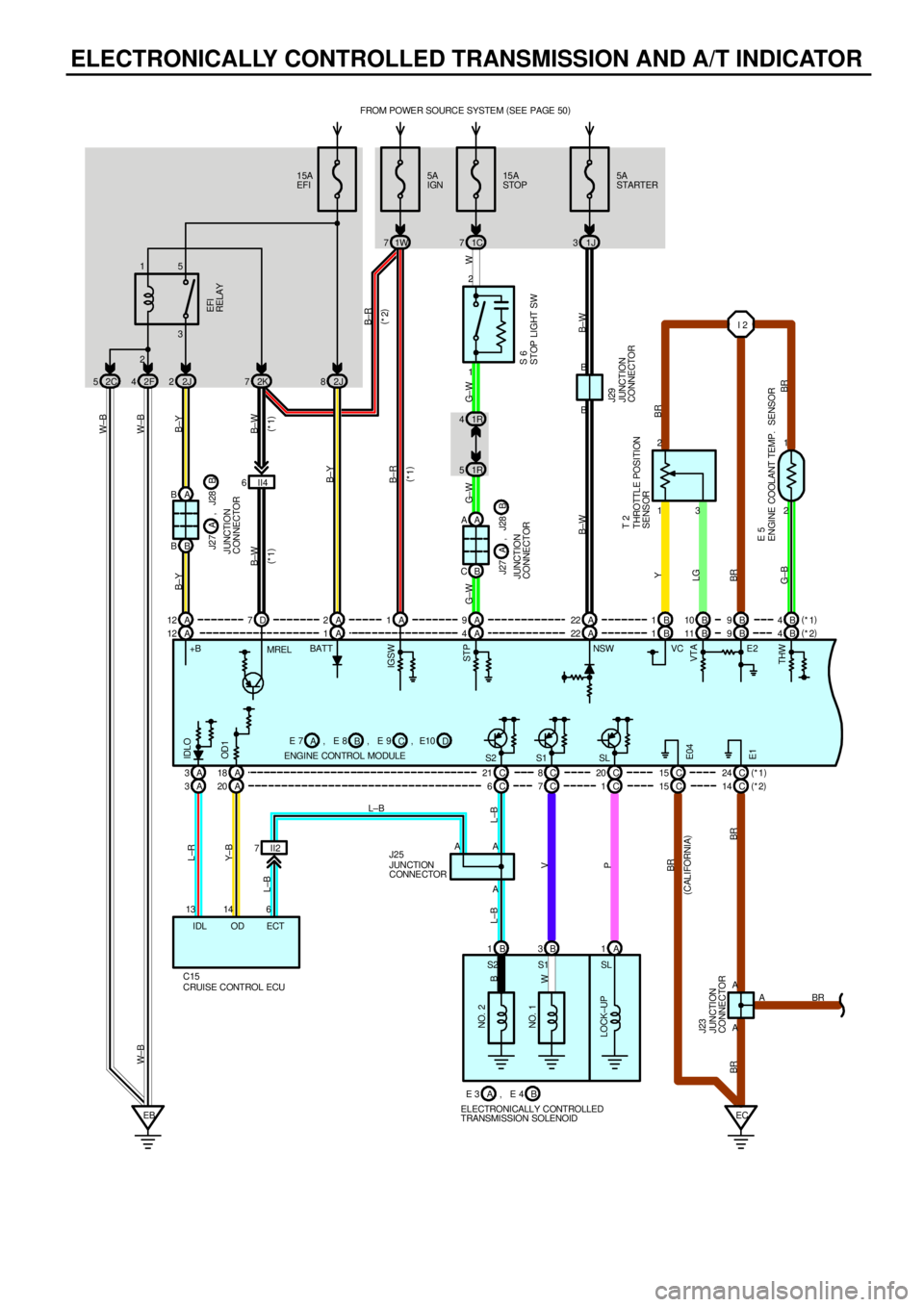
ELECTRONICALLY CONTROLLED TRANSMISSION AND A/T INDICATOR
15A
EFIFROM POWER SOURCE SYSTEM (
SEE PAGE 50)
2J 815A
STOP
1C 7
23 15
2F 42J2
1R 4
1R 51 2
1 2
2 1
A 4 A 1B 1B11 B4 B 9
C 21 C8C20 C24 A B
B BI 2
EBEC A
A A3
AA
G±WB±YB±Y W±B W± B
G± W G± W W
BR
BR G±BLGY
BR L±B L±B
V
P
BR BREFI
RELAY
BATTVC
STOP LIGHT SW
THROTTLE POSITION
SENSOR
ENGINE COOLANT TEMP. SENSORS 6
T 2
E 5 B
W
S2 S1 II2 7 A 3A18
CRUISE CONTROL ECU C156 13 14
L±BL±R
Y± B
ECT IDL ODA ENGINE CONTROL MODULEB ACD A 12
B±Y
+B
JUNCTION
CONNECTOR J23STP
VTA
THW IDLO
OD 1
E1
JUNCTION
CONNE CTOR J25 L±B5A
IGN
1W 7
B±R
2K 7
B±W B±W
IGSW
S1 SLE2
S2B 4 B 9 B 10 B 1 A 9 A 1 A 2 D 7 A 12(
*1)
(
*2) A A
B C
SL
NO. 2
NO. 1
LOCK±UP
B 1B3A1
E 3
ELECTRONICALLY CONTROLLED
TRANSMISSION SOLENOIDB A, E 4C 1 C 7 C 6 A 20 A 3E 7 , E 8 , E 9 , E10
B± R
(
*2)
(
*1)
J27
JUNCTION
CONNECTORB A, J28J27
J UNCTION
CONNECTORB A, J28
II4 6
(
*1) (
*1)
A 22A 225A
STARTER
1J 3
B±W B±W
JUNCTION
CONNECTOR J29
C 14 C 15
C 15
BR
(
CALIFORNIA)
(
*1)
(
*2)
BR B B
E04
MRELNSW 2C 5
W±B
Page 4437 of 4592
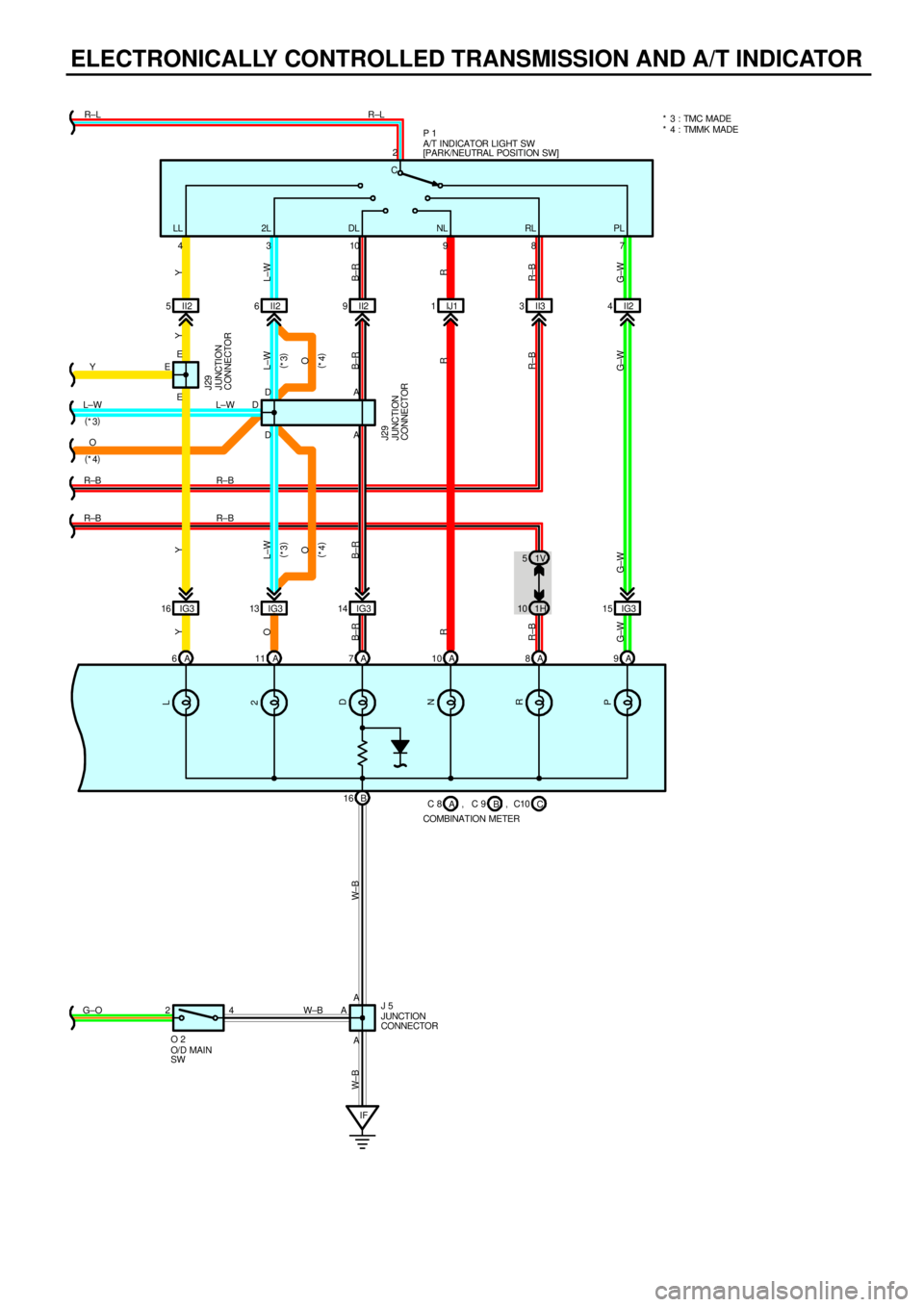
ELECTRONICALLY CONTROLLED TRANSMISSION AND A/T INDICATOR
A 6A11 A7A10 A8A9
B 16
IF II2 5 II26II29IJ11II33II24
IG3 16 IG313 IG314 IG315 LL 2L DL NL RL PL
43109872
1V 5
1H 10 EE
DDA
AA E
DA
A L±W
R±B
R±BR±L
W±B
Y
O
B±R
R
R±B
G±WY
L±W
B±RY
L±W
B±R
R
R±B
G±W W± B W± B
COMBINATION METERB C 8 C 9
ACC10
JUNCTION
CONNECTOR J 5A/T INDICATOR LIGHT SW
[PARK/NEUTRAL POSITION SW] P 1
JUNCTION
CONNECTOR J29J UNCTION
CONNECTOR J29 L
2
D
N
R
PY
L±W
B±R
R
R±B
G±W
G±OR±B R±B L±WY R±L
G±W
C
4 2
O/ D MAI N
SW O 2, , * 3 : TMC MADE
* 4 : TMMK MADE
(
*3) (
*3)
O
O
(
*4)(
*4) O
(
*4) (
*3)
Page 4438 of 4592
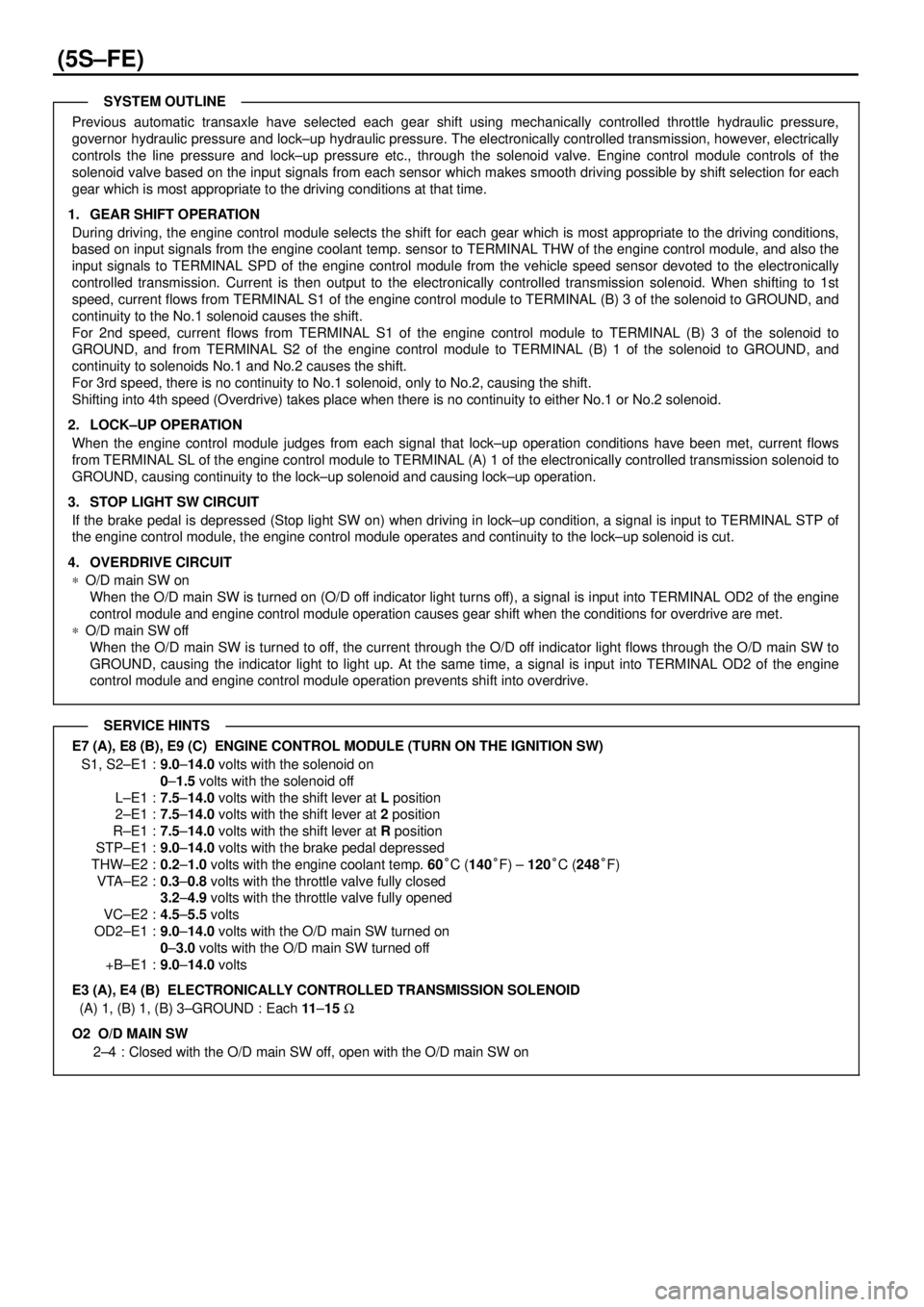
(5S±FE)
Previous automatic transaxle have selected each gear shift using mechanically controlled throttle hydraulic pressure,
governor hydraulic pressure and lock±up hydraulic pressure. The electronically controlled transmission, however, electrically
controls the line pressure and lock±up pressure etc., through the solenoid valve. Engine control module controls of the
solenoid valve based on the input signals from each sensor which makes smooth driving possible by shift selection for each
gear which is most appropriate to the driving conditions at that time.
1. GEAR SHIFT OPERATION
During driving, the engine control module selects the shift for each gear which is most appropriate to the driving conditions,
based on input signals from the engine coolant temp. sensor to TERMINAL THW of the engine control module, and also the
input signals to TERMINAL SPD of the engine control module from the vehicle speed sensor devoted to the electronically
controlled transmission. Current is then output to the electronically controlled transmission solenoid. When shifting to 1st
speed, current flows from TERMINAL S1 of the engine control module to TERMINAL (B) 3 of the solenoid to GROUND, and
continuity to the No.1 solenoid causes the shift.
For 2nd speed, current flows from TERMINAL S1 of the engine control module to TERMINAL (B) 3 of the solenoid to
GROUND, and from TERMINAL S2 of the engine control module to TERMINAL (B) 1 of the solenoid to GROUND, and
continuity to solenoids No.1 and No.2 causes the shift.
For 3rd speed, there is no continuity to No.1 solenoid, only to No.2, causing the shift.
Shifting into 4th speed (Overdrive) takes place when there is no continuity to either No.1 or No.2 solenoid.
2. LOCK±UP OPERATION
When the engine control module judges from each signal that lock±up operation conditions have been met, current flows
from TERMINAL SL of the engine control module to TERMINAL (A) 1 of the electronically controlled transmission solenoid to
GROUND, causing continuity to the lock±up solenoid and causing lock±up operation.
3. STOP LIGHT SW CIRCUIT
If the brake pedal is depressed (Stop light SW on) when driving in lock±up condition, a signal is input to TERMINAL STP of
the engine control module, the engine control module operates and continuity to the lock±up solenoid is cut.
4. OVERDRIVE CIRCUIT
*O/D main SW on
When the O/D main SW is turned on (O/D off indicator light turns off), a signal is input into TERMINAL OD2 of the engine
control module and engine control module operation causes gear shift when the conditions for overdrive are met.
*O/D main SW off
When the O/D main SW is turned to off, the current through the O/D off indicator light flows through the O/D main SW to
GROUND, causing the indicator light to light up. At the same time, a signal is input into TERMINAL OD2 of the engine
control module and engine control module operation prevents shift into overdrive.
E7 (A), E8 (B), E9 (C) ENGINE CONTROL MODULE (TURN ON THE IGNITION SW)
S1, S2±E1 :9.0±14.0 volts with the solenoid on
0±1.5 volts with the solenoid off
L±E1 :7.5±14.0 volts with the shift lever at L position
2±E1 :7.5±14.0 volts with the shift lever at 2 position
R±E1 :7.5±14.0 volts with the shift lever at R position
STP±E1 :9.0±14.0 volts with the brake pedal depressed
THW±E2 :0.2±1.0 volts with the engine coolant temp. 60°C (140°F) ± 120°C (248°F)
VTA±E2 :0.3±0.8 volts with the throttle valve fully closed
3.2±4.9 volts with the throttle valve fully opened
VC±E2 :4.5±5.5 volts
OD2±E1 :9.0±14.0 volts with the O/D main SW turned on
0±3.0 volts with the O/D main SW turned off
+B±E1 :9.0±14.0 volts
E3 (A), E4 (B) ELECTRONICALLY CONTROLLED TRANSMISSION SOLENOID
(A) 1, (B) 1, (B) 3±GROUND : Each 11±15 W
O2 O/D MAIN SW
2±4 : Closed with the O/D main SW off, open with the O/D main SW on
SYSTEM OUTLINE
SERVICE HINTS
Page 4444 of 4592
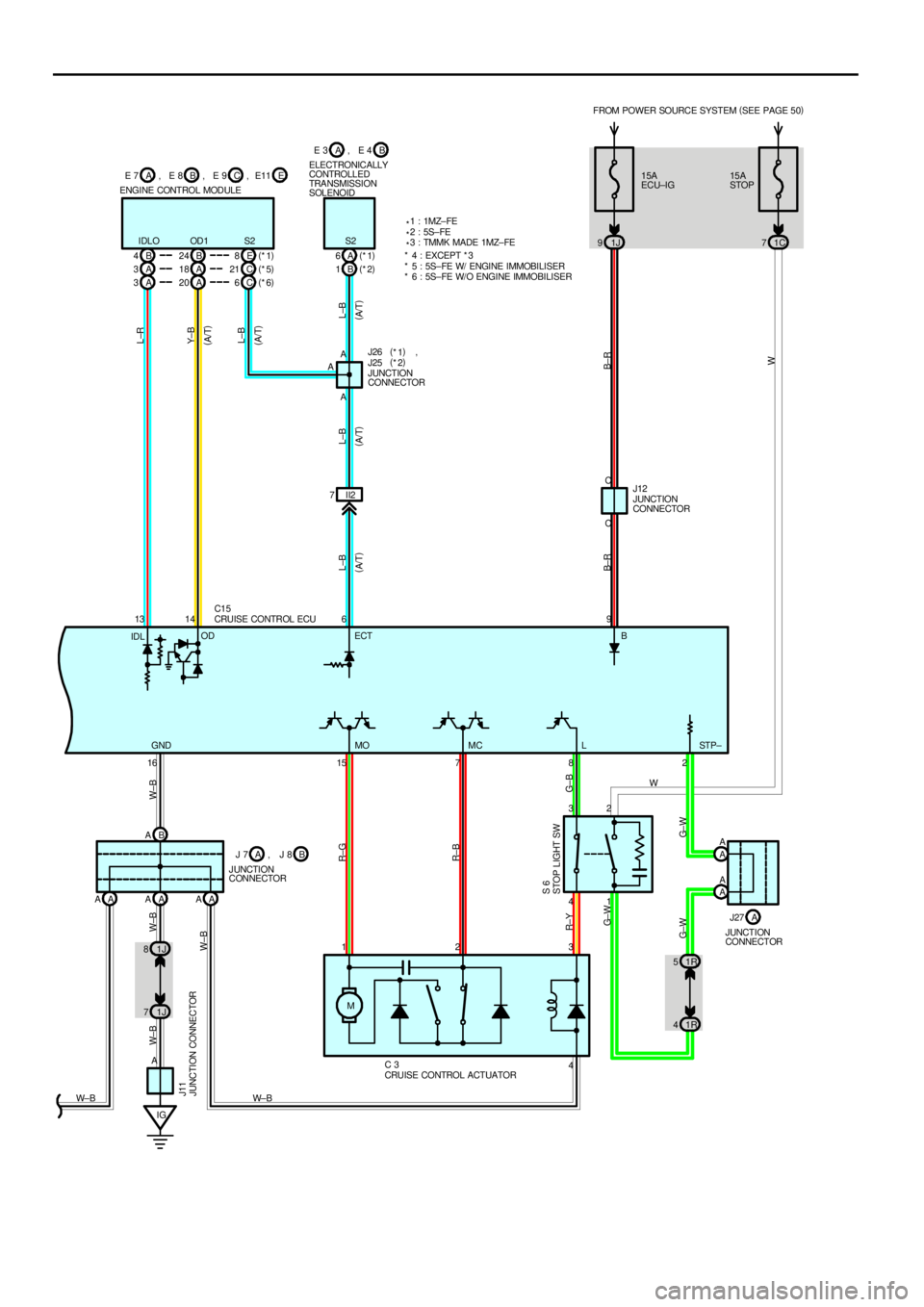
15A
ECU±IG
1J 9
E 8 B 24 B 4A6
B 115A
STOP FROM POWER SOURCE SYSTEM (
SEE PAGE 50)
1C 7
A AAAAA B A
IG1R 5
1R 4 16 15 8 2
41
4 A
C
12332
AAA
C
W± BGNDST P± IDLO OD1 S2
7 13 14 6 9
ECT B
L±B L±B Y± B L±R
L±B
B± RL±B
B±R
W W±B
R±G
R±B
G±B R±Y W±B
G± W
W
W± BJUNCTION
CONNECTOR J25
JUNCTION
CONNECTOR J12
STOP LIGHT SW S 6
ENGINE CONTROL MODULEELECTRONICALLY
CONTROLLED
TRANSMISSION
SOLENOID
J UNCTION
CONNECTOR
CRUISE CONTROL ACTUATOR C 3
G±W G±W
* 1 : 1MZ± FE
* 2 : 5S±FE
J26(
*1)
(
*2)
CRUISE CONTROL ECU C15
(
A/T)
(
A/T)
(
A/ T) (
A/T) (
A/ T)
(
*1)
(
*2) (
*1)
1J 8
1J 7
W±B W± B
M
JUNCTION CONNECTOR J11
OD
IDL
MO MC L II2 7S2
A A
A A
JUNCTION
CONNECTOR B E 3 A , E 4
E E 9 C , E11
A 3A 3
A 20A 18
C 6(
*6) C 21(
*5)
B J 7 A , J 8
J27 A * 4 : EXCEPT * 3
* 5 : 5S±FE W/ ENGINE IMMOBILISER
* 6 : 5S±FE W/O ENGINE IMMOBILISER* 3 : TMMK MADE 1MZ±FE E 7 BA, E 8 ,
,
Page 4445 of 4592

CRUISE CONTROL
Current is applied at all times through the STOP fuse to TERMINAL 2 of the stop light SW.
With the ignition SW turned to on, current flows through the GAUGE fuse to TERMINAL (C) 7 of the combination meter and
the current through the ECU±IG fuse flows to TERMINAL 9 of the cruise control ECU.
When the ignition SW is on and the cruise control SW is turned on, a signal is input from TERMINAL 5 of the cruise control
SW to TERMINAL 11 of the cruise control ECU. As a result, the cruise control ECU functions and the current flows from the
ECU±IG fuse to TERMINAL 9 of the cruise control ECU to TERMINAL 16 to GROUND, and the cruise control system is in a
condition ready for operation.
At the same time, the current through the GAUGE fuse flows to TERMINAL (C) 7 of the cruise control indicator light to
TERMINAL (C) 10 to TERMINAL 4 of the cruise control ECU to TERMINAL 16 to GROUND, causing the cruise control
indicator light to light up, indicating that cruise control is ready for operation.
1. SET OPERATION
When the cruise control SW is turned on and the set SW is pushed with the vehicle speed within the set limit (Approx. 40
km/h, 25 mph to 200 km/h, 124 mph), a signal is input to TERMINAL 10 of the cruise control ECU and the vehicle speed at
the time the set SW is released is memorized in the ECU as the set speed.
2. SET SPEED CONTROL
During cruise control driving, the cruise control ECU compares the set speed memorized in the cruise control ECU with the
actual vehicle speed input into TERMINAL 12 of the cruise control ECU from the speed sensor, and controls the cruise
control actuator to maintain the set speed.
When the actual speed is lower than the set speed, the ECU causes the current to the cruise control actuator to flow from
TERMINAL 15 of the cruise control ECU to TERMINAL 1 of the cruise control actuator to TERMINAL 2 to TERMINAL 7 of
the cruise control ECU. As a result, the motor in the cruise control actuator is rotated to open the than the set speed, the
current to the cruise control actuator flows from TERMINAL 7 of the cruise control ECU to TERMINAL 2 of the cruise control
actuator to TERMINAL 1 to TERMINAL 15 of the cruise control ECU.
This causes the motor in the cruise control actuator to rotate to close the throttle valve and return the throttle cable to
decrease the vehicle speed.
3. COAST CONTROL
During cruise control driving, while the coast SW is on, the cruise control actuator returns the throttle cable to close the
throttle valve and decrease the driving speed. The vehicle speed when the coast SW is turned off is memorized and the
vehicle continues at the new set speed.
4. ACCEL CONTROL
During cruise control driving, while the accel SW is turned on, the cruise control actuator pulls the throttle cable to open the
throttle valve and increase the driving speed.
The vehicle speed when the accel SW is turned off is memorized and the vehicle continues at the new set speed.
5. RESUME CONTROL
Unless the vehicle speed falls below the minimum speed limit (Approx. 40km/h, 25mph) after canceling the set speed by the
cancel SW, pushing the resume SW will cause the vehicle to resume the speed set before cancellation.
6. MANUAL CANCEL MECHANISM
If any of the following operations occurs during cruise control operation, the magnetic clutch of the actuator turns off and the
motor rotates to close the throttle valve and the cruise control is released.
*Placing the shift lever except D position (Park/Neutral position SW except D position). ºSignal is not input to TERMINAL 3
of the cruise control ECUº (A/T)
*Depressing the clutch pedal (Cruise control clutch SW off). ºSignal input to TERMINAL 3 of the cruise control ECUº (M/T)
*Depressing the brake pedal (Stop light SW on). ºSignal input to TERMINAL 2 of the cruise control ECUº
*Pushing the cancel switch (Cancel SW on). ºSignal input to TERMINAL 10 of the cruise control ECUº
*Pushing the cruise switch off ºsignal input to TERMINAL 11 of the cruise control ECUº.
SYSTEM OUTLINE
Page 4446 of 4592

7. TAP±UP CONTROL FUNCTION
When the difference between the actual vehicle speed and the set speed is less than 5 km/h (3 mph), the set speed can be
increased 1.6 km/h (1 mph) each time by operation the RESUME/ACCEL SW quickly within 0.6 seconds.
8. TAP±DOWN CONTROL FUNCTION
When the difference between the actual vehicle speed and the set speed is less than 5 km/h (3 mph), the set speed can be
lowered 1.6 km/h (1 mph) each time by operating the SET/COAST SW quickly within 0.6 seconds.
9. AUTO CANCEL FUNCTION
A) If any of the following operating conditions occurs during cruise control operation, the set speed is erased, the current
flow to the magnetic clutch is stopped and the cruise control is released. (Cruise SW turns off).
When this occurs, the ignition SW must be turned off once before the cruise SW will turn on.
*When current continued to flow to the motor inside the actuator in the throttle valve ºOPENº direction.
*The motor does not operate despite the motor drive signal being output.
B) If any of the following operating conditions occurs during cruise control operation, the set speed is erased, the current
flow to the magnetic clutch is stopped and the cruise control is released. (Cruise SW turn off).
When this occurs, the cancel state is cleared as the cruise SW will turn on again.
*Over current to transistor driving the motor and/or the magnetic clutch.
*Open circuit in the magnetic clutch.
*Momentary interruption of vehicle speed signal.
*Short circuit in the cruise control SW.
*When the vehicle speed falls more than 16 km/h (10 mph) below the set speed, E.G. on an upward slope.
C) If any of the following conditions occurs during cruise control operation, the set speed is erased and the cruise control is
released. (The power to the magnetic clutch is cut off until the set SW is ON again.)
*When the vehicle speed falls below the minimum speed limit, approx. 40 km/h (25 mph).
*When power to the cruise control system is momentarily cut off.
D) If any of the following conditions occurs during cruise control operation, the cruise control is released.
*Open the circuit for TERMINAL 2 of the stop light SW.
10. AUTOMATIC TRANSAXLE CONTROL FUNCTION
*In overdrive. If the vehicle speed becomes lower than the overdrive cut speed (Set speed minus approx. 4 km/h, 2.5 mph)
during cruise control operation, such as driving up a hill, the overdrive is released and the power increased to prevent a
reduction in vehicle speed.
*After releasing the overdrive, vehicle speed becomes higher than the overdrive return speed (Set speed minus approx. 2
km/h, 1.2 mph) and the cruise control ECU judges by the signals from the actuator's potentiometer that the upward slope
has finished, the overdrive is resumed after approximately 2 seconds.
*During cruise control driving, the cruise control operation signal is output from the cruise control ECU to the engine control
module. Upon receiving this signal, the engine control module changes the shift pattern to normal.
To maintain smooth cruise control operation (on a downward slope etc.), the lock±up release of the transmission when the
idling point of the throttle position is ON is forbidden.
C3 CRUISE CONTROL ACTUATOR
3±4 : Approx. 38.5 W
C12 CRUISE CONTROL SW [COMB. SW]
5±3 : Continuity with the CRUISE SW on
4±3 : Approx. 418 W with the CANCEL SW on
Approx. 68 W with the RESUME/ACCEL SW on
Approx. 198 W with the SET/COAST SW on
C15 CRUISE CONTROL ECU
9±GROUND :10±14 volts with the ignition SW at ON position
12±GROUND :4 pulses with 1 rotation of rotor shaft
10±GROUND : Approx. 418 W with the CANCEL SW on in the cruise control SW
Approx. 198 W with the SET/COAST SW on in the cruise control SW
Approx. 68 W with the RESUME/ACCEL SW on in the cruise control SW
16±GROUND : Always continuity
SERVICE HINTS